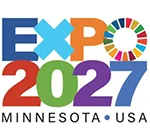Remarks for Kate James
Gates Foundation Chief Communications Officer
At the Institute for Public Relations Dinner
“The Business of Changing the World”
New York, New York
November 21, 2013
- I. INTRODUCTION/ATTENTION
Thank you very much. It’s a huge honor to be here tonight.
I was just listening to Ken introducing the speech and the title – the business of changing the world – and I was reminded of how grandiose it might seem.
But actually, on reflection of the title – changing the world is Bill and Melinda’s ambition. It’s about making a huge impact on the lives of the billions of people that live in extreme poverty.
And why do we think of it as a business? Well, the approach we take is much the same as the one you take.
To give this some context – I’m sure nearly everyone in this room has worked on a campaign where it was clear that the outcome would be a market moving event.
Now what if that campaign was about a new vaccine that could reduce malaria cases by a quarter? What if, instead of a rising stock price, a good outcome was a rise in the number of children who live to see their fifth birthday?
These campaigns have been my job for the last four years.
And doing that job has helped me realize that the world’s biggest development challenges … and what you see as your firm’s and your client’s biggest opportunities … are more linked than ever before.
And that linkage is what I’d like to talk about this evening.
- II. WHERE I’M COMING FROM
I first started thinking about the links between development challenges and business in the early 2000s, when I went to work as group head of public affairs at Standard Chartered.
Standard Chartered’s business is largely focused on Africa, Asia, and the Middle East. And my time at the bank gave me a unique perspective on the HIV/AIDS crisis that was ravaging sub-Saharan Africa. For the first time, I saw not just the humanitarian crisis, but also the economic impact. For example, in Kenya we had up to 10 percent of our workforce either ill, or looking after somebody who was ill. This didn’t just impact our employees, but our suppliers and our customers as well.
That’s when I began to really think about developing markets and the challenges there. At Standard Chartered, we made the commitment to provide antiretrovirals and programs promoting AIDS and HIV awareness. It wasn’t just a nice philanthropic initiative – it was really fundamental to our operations.
And through that experience, I learned a simple lesson: Increasingly, the morally right thing to do is also the right thing to do for your business.
A recent piece in DealBook was critical of how much Goldman Sachs spends on CSR, including a quote from Warren Buffett, one of our own trustees, saying that spending shareholders’ money is not the right approach. And this is why thinking about philanthropy as just the right thing to do has its limitations.
CSR efforts need to align to the bottom line – to facilitate market access, consumer engagement, employee motivation – and it’s only then that you start to see the ROI. It’s not just about the size of the check, but how companies use their intellectual expertise and human capital.
Standard Chartered gave me my sense of social responsibility. And that’s when I decided that more than anything else, I wanted to work at the Gates Foundation. I wanted to help change the world. So I took the next natural step.
I went to work at Citibank.
During the financial crisis.
Comms I can manage. My career….not so much.
- III. TURNING AGREEMENT INTO ACTION
Ultimately though, the story has a happy ending. I did make it to the Gates Foundation.
For those of you not familiar with our work, we are a family foundation driven by Bill and Melinda’s belief that all lives have equal value. In the US we focus largely on education, but around the world we work on some of the biggest and most complex development challenges – from eradicating polio to helping millions of small farmers out of poverty.
In the years since I started at the foundation, the communications world has transformed.
But there’s one thing that hasn’t changed. No matter who you work with – no matter who you reach out to – there is always an enormous gulf between agreement and action.
To put it in advertising terms, agreement is seeing a TV commercial and thinking, “Hey, that was clever.” Action is actually going out and buying the product. And sometimes in our space it feels like the distance between them is eternal.
People overwhelmingly agree that it’s right to save lives in the developing world. They agree that it’s not right for huge numbers of children to be cut off from education, healthcare, and the chance at a decent life.
But somewhere between that agreement and needed action, we lose most people.
For a while during the internet revolution of the 1990s, it felt like this problem might finally be solved. Here was this incredible new tool that could connect our message with the world instantly – that could connect decision makers to the people who are actually being impacted on the ground.
In some cases, that promise is being realized. I spend a lot of time in China – and I’ve been really struck by the huge commitment of Chinese social media leaders to look at social media as an opportunity for social good.
Leading companies like Tencent, Renren, Sina, Baidu, and Alibaba have put aside competition and formed an alliance that focuses on social good. They don’t do this just because they care, although I believe they do. They do it because the halo effect provided by their partnership with each other and with our foundation gives them more freedom to operate in the Chinese marketplace. That self-interest has translated into positive social impact.
To give you an example, last year the Alliance launched an online campaign for World No Tobacco Day – a campaign that previously might never have been considered given the power of the Chinese tobacco industry. As a result of the campaign, national awareness of the “Say No to Forced Smoking” message increased from just 5% to 20% in just one month.
This is a great example of how technology can be used to help solve pervasive challenges.
Given who my boss is, it’s probably not surprising that we try to find as many ways as possible to bring the worlds of development and technology together. But we’re still just scratching the surface of that enormous potential.
At the foundation, we’ve seen some successes, like our partnerships with TEDxChange and the Social Good Summit, which engage digital communities in development issues and help connect decision makers with people on the ground. But despite these few green shoots, we’ve still got a long way to go.
- IV. DOVE: A CAMPAIGN THAT WORKED
One problem is that we in the development community have been pitching the wrong story. If people aren’t buying what we have to sell, it’s because we haven’t packaged our product in the right way.
At the foundation we’re often referred to as data geeks. We’re evidence based and rightly so. Data plays a vital role in how we make the case and show the progress. But statistics only get us so far. In an age of big data, we have to remember that while data provides the rigor and the credibility, it doesn’t drive emotional engagement.
Many of you are probably familiar with the Dove Campaign for Real Beauty. In fact, some of you were probably involved in designing it. Dove flooded the internet with viral videos that forced people to rethink their ideals of beauty.
What is impressive from my perspective about that campaign is that it forges an incredibly strong connection between consumer and product. And let me remind you – that product is soap.
Now, I’m not knocking soap. It’s an important part of all our lives. In seriousness, it’s deeply important to a lot of our sanitation efforts worldwide. But this campaign is more successful than the vast majority of non-profit campaigns that are fighting to give people access to basic human rights – education, clean drinking water, health.
So when I think about this campaign, I keep thinking about a basic question. Why are people more engaged by a bar of soap than the 2.9 million infants who die each year before they turn a month old? (There are places in the world today where families still don’t name their children immediately because survival is such a chancy thing.)
Of course - the Dove campaign wasn’t selling soap. It was selling self-esteem.
And that raises a simple question about what we as a foundation and our sector are selling. Maybe instead of opening with a message about disease and deprivation, we should lead with a message of human progress and potential.
In fact, there’s no “maybe” about it. When it comes to global development, we are having the wrong conversation.
- V. EMPHASIZING WHAT WE’RE WORKING TOWARD
To give this some context, if I say “malaria” what do you picture?
Do you see a mosquito? Do you see a bed net? Or do you see a sick child?
If it’s the sick child that you see, I don’t blame you. Because so much outreach in this area capitalizes on what we call the “flies in the eyes” images.
The picture that I want you to see is a happy healthy child that has had access to all of the tools that are available today to prevent this deadly disease. Because this picture is what’s actually happening across Africa today. Malaria cases and deaths have been dropping for about a decade. Since 2000, the lives of 1.1 million African children have been saved from malaria.
I want you to see the opportunity that comes when an entire generation is freed from disease. I want you to see the impact this can have on a country’s economic development.
Why? Because the issues we work on are large and complex and the solutions are not found in weeks or months, but they take years and even decades. And whilst Bill and Melinda’s generosity is extraordinary – they give away around $4 billion a year -- it’s a drop in the ocean in terms of what needs to be invested in development to solve these big, complex problems.
In a tough global economic environment, we need governments and other donors to see investment in aid as a good return and we need the public to see and believe in the progress that’s being made.
That’s why when it comes to our top priority, polio, we don’t talk about paralysis; we talk about hope. We talk about the fact that through the amazing efforts and the incredible dedication of our partners, from Rotary to FC Barcelona -- and through their decades of work -- we’ve already eliminated 99 percent of the polio cases in the world.
The disease is now only endemic in three countries - Nigeria, Pakistan and Afghanistan – and this year, we’ve seen a 45% drop in cases in those countries. But we’ve also seen recent outbreaks in the Horn of Africa and in Syria. Now there’s the threat we may see polio once again in Europe. We can’t let this happen and we don’t need to.
We have the opportunity to eradicate a disease from the planet for only the second time in history. But we know that polio is like a bush fire. You have to wipe it out totally or it flares up again. We owe it to the hundreds of thousands of people who’ve been working for decades to make this possible.
I’d like to show a video that asks this simple question: we’ve come this far. Why would we stop now?
[SHOW 99% VIDEO]
- VI. IMPLICATIONS FOR ALL OF US
We all have a role to play in these development conversations, even if it feels like your business couldn’t be further away from the world of development.
People have a tendency to imagine that all problems in the world are happening in far off places… affecting people who don’t affect your life or work. But it’s really not the case.
How many of you are seeking to do business or have done business in India?
This is one of the most rapidly expanding markets in the world. I know that many of you are rightly excited about it. But today, India has a higher malnutrition rate than Sub-Saharan Africa. India’s largest state is also one of the poorest places in the world.
Seven of the 10 fastest growing economies in the next decade are in sub-Saharan Africa. But this is also the world headquarters of AIDS and malaria.
Brazil is the up-and-coming world leader hosting the World Cup and the Olympics. But it also has the world’s largest burden of dengue fever – the “bone crush fever.”
And of course, the market with the most potential of them all – China.
Last month I was in China and had the opportunity to sit down with patients suffering from drug resistant TB. Farmers living in extreme rural poverty having to support their families and use their whole monthly salary on the drugs they need to fight this terrible disease. What was striking was that these farmers lived only an hour and a half away from the center of Beijing.
The next day I found myself in meetings at Tencent’s gleaming headquarters – competing with Facebook to be the largest social networking company in the world, Tencent’s market value is over $100 billion.
There aren’t neat walls between the emerging markets that interest you, and the people who are struggling in these very same places. You can’t engage with one without engaging in the other.
- VII. CALL TO ACTION
Today, some of the biggest, most interesting, fastest growing markets in the world are also places where development challenges are front and center in people’s minds. And if we don’t solve those challenges, these nations – and the people within them – will never reach their full potential.
The scope of these opportunities is currently constrained by our ability to address the biggest challenges facing the developing world. And that’s why you need you to get involved. Because increasingly, the developing world is the world we’re all operating in.
As leaders, as global citizens, and influencers, you’re fortunate enough to have the chance to engage with these issues first-hand.
I’m not suggesting that you have to spend all your time in AIDS clinics from here on out, but I do think it’s important to have a textured understanding of what life is like in your key markets.
These aren’t just the lessons I’d like you to take away tonight – I’m also taking them with me. As Ken mentioned, in the New Year I’ll be starting a new role as chief corporate affairs officer at the world’s largest education company, Pearson. Pearson has a massive responsibility – the education of the next generation.
And it may be clearer at a place like Pearson where market forces and social change intersect, but if you look closely – they’re intersecting everywhere.
When your companies look to you, they aren’t just asking for your communications insights. They look to you for your understanding of the world in which they operate.
Quite frankly, you can’t have a complete understanding of the world unless you have a robust understanding of the development challenges that we face today.
So if you’re still thinking about these issues as far away and irrelevant to you, then you are already falling behind.
The barriers between nations are becoming more and more porous. And if you are seeking success in this still young century, you have to understand these issues. You have to engage with these issues.
Because if we can leverage your influence, your power, then I’m confident that we really can change the world.
Thank you very much.


 AB InBev has hired Donna Lorenson as chief communications officer and elevated the PR function to the senior leadership structure in the aftermath of the Bud Light marketing disaster.
AB InBev has hired Donna Lorenson as chief communications officer and elevated the PR function to the senior leadership structure in the aftermath of the Bud Light marketing disaster. Tunheim handled the Minnesota USA World Expo bid committee, which on June 21 congratulated Serbia for landing the 2027 event.
Tunheim handled the Minnesota USA World Expo bid committee, which on June 21 congratulated Serbia for landing the 2027 event. United Minds, management consultancy, has launched Myriant, a business resiliency offering to help clients deal with the challenges during this era of misinformation, polarization and geopolitical upheaval.
United Minds, management consultancy, has launched Myriant, a business resiliency offering to help clients deal with the challenges during this era of misinformation, polarization and geopolitical upheaval.  ImageShield, which guards against online image abuse, is looking for a communications pro to handle its PR and marketing campaigns.
ImageShield, which guards against online image abuse, is looking for a communications pro to handle its PR and marketing campaigns. Who knew that there is a real paper company, Pennsylvania Paper & Supply, inside the iconic building seen at the opening of every episode of “The Office?”
Who knew that there is a real paper company, Pennsylvania Paper & Supply, inside the iconic building seen at the opening of every episode of “The Office?” 


 Have a comment? Send it to
Have a comment? Send it to 
No comments have been submitted for this story yet.